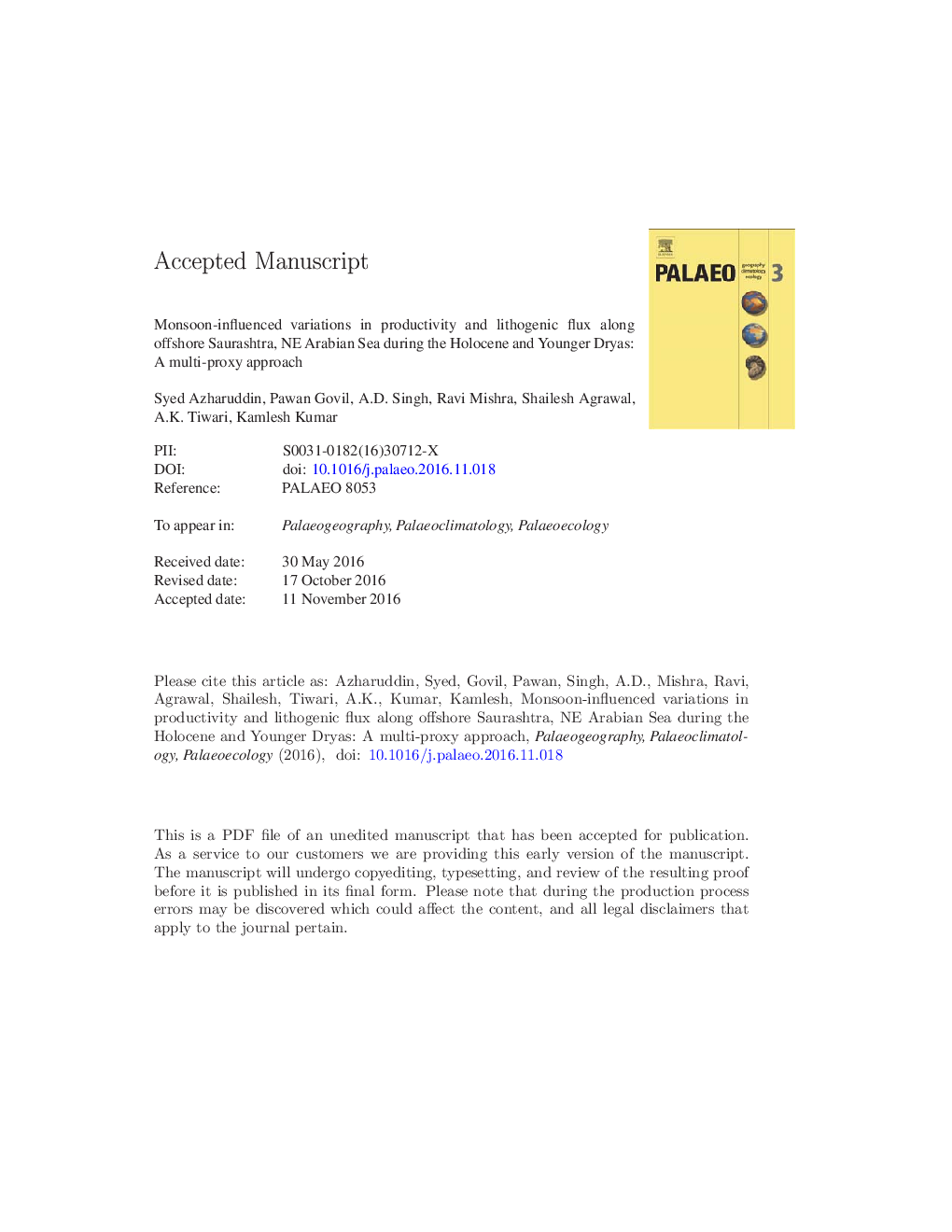| کد مقاله | کد نشریه | سال انتشار | مقاله انگلیسی | نسخه تمام متن |
|---|---|---|---|---|
| 5755647 | 1622109 | 2017 | 48 صفحه PDF | دانلود رایگان |
عنوان انگلیسی مقاله ISI
Monsoon-influenced variations in productivity and lithogenic flux along offshore Saurashtra, NE Arabian Sea during the Holocene and Younger Dryas: A multi-proxy approach
ترجمه فارسی عنوان
تغییرات موثر در بهره وری و شیب لیتوژنیک در ساوه دریای ساواسورترا، دریای عریق دریایی در طی هولوسن و جوانتر خشکا: یک رویکرد چند پروکسی
دانلود مقاله + سفارش ترجمه
دانلود مقاله ISI انگلیسی
رایگان برای ایرانیان
کلمات کلیدی
پائئوسکلیمات، دریای عربی دریای خزر، ایزوتوپ اکسیژن، فورنینیفور پلانکتونی، ساراشترا دریایی،
موضوعات مرتبط
مهندسی و علوم پایه
علوم زمین و سیارات
فرآیندهای سطح زمین
چکیده انگلیسی
A sediment core from NE Arabian Sea was studied to reveal the variations in shelf environment of western continental margin of India. A multi-proxy analysis based on planktonic foraminifera abundance (PFA), benthic foraminifera abundance (BFA), planktonic-benthic foraminiferal ratio (P/B), CaCO3 percentage (wt%), Oxygen (δ18OG. ruber) and Carbon (δ18OG. ruber) isotopes of foraminifera as well as sediment X-ray studies were carried out on 3.4 m long core SK-240/485 recovered from offshore Saurashtra, NE Arabian Sea. The study aims to understand the monsoon variability in the NE Arabian Sea offshore Saurashtra since the late Pleistocene-Holocene transition and how monsoon climate coupled with sea-level change influenced paleo-productivity pattern. Six AMS radiocarbon dates place the core in the time interval 12-1 Ka. Our study reveals that there have been three periods of major changes in the monsoonal climate, productivity and sea level; viz. 12-8 Ka (Younger Dryas and early Holocene); 8-4 Ka (middle Holocene) and 4-1 Ka (late Holocene). The studied time period was also marked by weakened south west monsoon (SWM) during the cold events such as Younger Dryas (YD), Abrupt Event (AE) centring around 9.8 Ka as well as 8.2 and 4 Ka cold events. The Younger Dryas and early Holocene shows the low sea level stand and less Indus river discharge. Thereafter during middle and late Holocene the monsoon strengthened which resulted in raised sea level and increased Indus river discharge. The proxy records broadly suggest relatively low foraminiferal productivity at the core location during the Younger Dryas and early Holocene. We record a moderate foraminiferal productivity during the middle Holocene between 8 and 4 Ka, which suggest the mesotrophic condition. The foraminiferal productivity however was relatively high since 4 Ka suggesting the eutrophic conditions at the core site.
ناشر
Database: Elsevier - ScienceDirect (ساینس دایرکت)
Journal: Palaeogeography, Palaeoclimatology, Palaeoecology - Volume 483, 1 October 2017, Pages 136-146
Journal: Palaeogeography, Palaeoclimatology, Palaeoecology - Volume 483, 1 October 2017, Pages 136-146
نویسندگان
Syed Azharuddin, Pawan Govil, A.D. Singh, Ravi Mishra, Shailesh Agrawal, A.K. Tiwari, Kamlesh Kumar,
